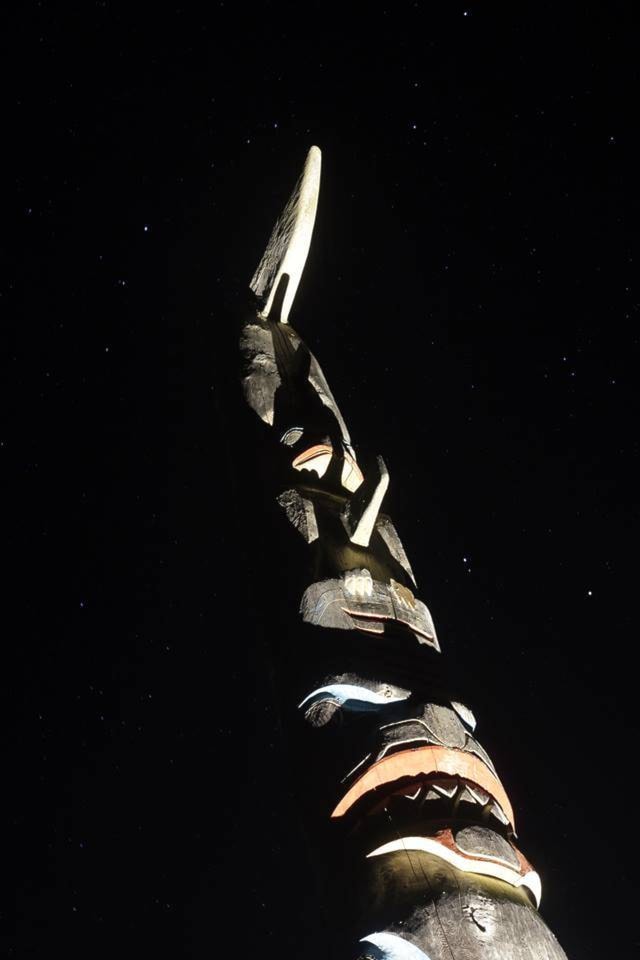By Samantha Bell
From Oct. 2 until Nov. 7, the Haida Gwaii skies will flash thanks to the Orionid meteor shower. Caused by Earth passing through debris left behind by Halley’s Comet when it streaked through the inner solar system, this shower will peak two days after the new moon, on the morning of Oct. 21. Looking southeast towards the constellation of Orion the Hunter, you should be able to see up to 20 meteors an hour at a dark location.
From Oct. 17 to Nov. 2, you will also have an increased chance of seeing the Zodiacal Light. Look for a faint, cone-shaped light in the east just before dawn — it caused by sunlight reflecting off the dust above Earth’s atmosphere, in this case the dust from the Orionid meteors.
Jupiter starts the month low in the western sky and will sink lower each evening until it disappears below the horizon at the end of the first week of October. It will pass behind the sun on Oct. 26 and will reappear in early November. Due to its brightness, you should be able to see it from an unobstructed location or between the mountains.
Mercury will linger slightly south of Jupiter in the sky, and will slide behind the sun on Oct. 8.
Saturn will be in the southwest for October, making it easier to see than Jupiter or Mercury. It will be visible just after twilight and will slowly sink towards the horizon over October. Saturn’s rings will be tilted towards Earth at 27 degrees, the maximum angle possible. The last time the rings were this open was 2003, and they will not approach this tilt again until 2032. This would be a good time to look through your telescope and see how many individual rings you can count. Don’t forget to look for the “spokes” — light structures that look like spokes on a wheel that randomly appear and disappear on Saturn’s rings.
Uranus reaches i’s best viewing on Oct. 19 when it lies directly opposite the sun (an alignment called “opposition”). It will be its brightest then, and visible all night. Don’t worry if it’s cloudy as this planet will remain bright all month, resting among the stars of Pisces. You should be able to spot Uranus with the naked eye under a dark sky. If not, then grab the binoculars. This would be a great time to look through the telescope since the planet will soon be at its highest point in the sky since 1963. This height will be reached around 1 a.m. on Oct. 19, which will minimize the atmospheric interference for your observation. Uranus will rise in the east and set in the west with a slight Southern bend to its course.
Neptune will appear in the southeast as darkness falls this month, reaching its highest point around 11 p.m. It will rise earlier each night until it reaches its highest point in the sky around 9 p.m. You will need binoculars or a telescope to see this planet as it resides in Aquarius for most of October. If you are unsure what spot of light is the planet, point a telescope at it to reveal its blue-gray disk.
Venus and Mars will stick close together in the east during October, with Venus rising about 13 minutes before Mars. The two will be about half a moon’s distance apart on Oct. 5, when they will be at their closest since November 1995. The planets will begin to separate afterwards, with Venus moving faster than Mars due to its inner solar orbit. On Oct. 17, a thin crescent moon will stand to the left of Mars and above Venus.
Did you know that because the planets in our solar system have different masses, they have different gravity? A 200-pound person on Earth would weight just 56.8 pounds on Mars, 181 pounds on Venus, 76 pounds on Mars, a whopping 501 pounds on Jupiter, 185 pounds on Saturn, 159 pounds on Uranus, and 225 pounds on Neptune. The best planet to step lightly on to scale might be Mercury, but personally I think I would prefer Mars simply for habitability.
Of course you could always adjust your scale, or do what I do and just not use it. It’s definitely cheaper than space flight, with the added bonus that a miscalculation will not send you into the sun.
